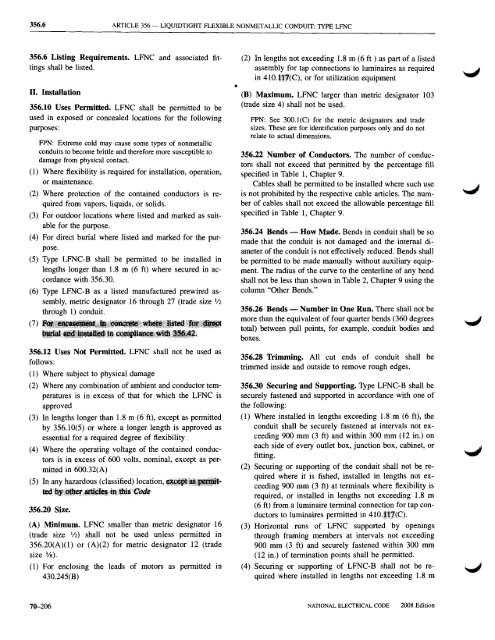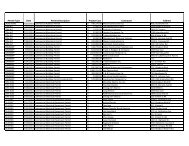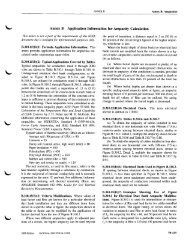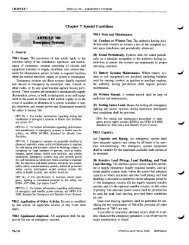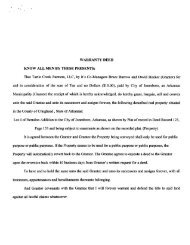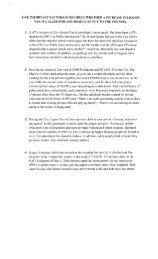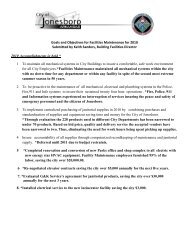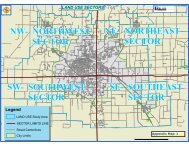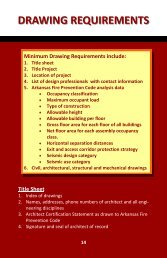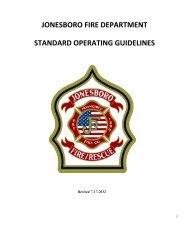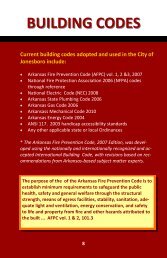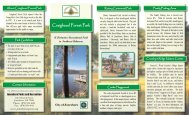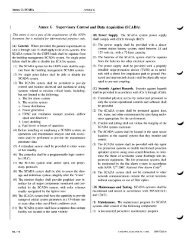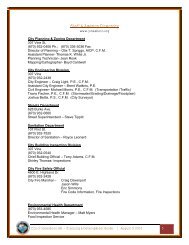Chapter 3 Wiring Methods and Materials
Chapter 3 Wiring Methods and Materials
Chapter 3 Wiring Methods and Materials
Create successful ePaper yourself
Turn your PDF publications into a flip-book with our unique Google optimized e-Paper software.
356.6 ARTICLE 356 - LIQUIDTIGHT FLEXIBLE NONMETALLIC CONDUIT: lYPE LFNC<br />
356.6 Listing Requirements. LFNC <strong>and</strong> associated fittings<br />
shall be listed.<br />
II. Installation<br />
356.10 Uses Permitted. LFNC shall be permitted to be<br />
used in exposed or concealed locations for the following<br />
purposes:<br />
FPN: Extreme cold may cause some types of nonmetallic<br />
conduits to become brittle <strong>and</strong> therefore more susceptible to<br />
damage from physical contact.<br />
(1) Where flexibility is required for installation, operation,<br />
or maintenance.<br />
(2) Where protection of the contained conductors is required<br />
from vapors, liquids, or solids.<br />
(3) For outdoor locations where listed <strong>and</strong> marked as suitable<br />
for the purpose.<br />
(4) For direct burial where listed <strong>and</strong> marked for the purpose.<br />
(5) Type LFNC-B shall be permitted to be installed in<br />
lengths longer than 1.8 m (6 ft) where secured in accordance<br />
with 356.30.<br />
(6) Type LFNC-B as a listed manufactured prewired assembly,<br />
metric designator 16 through 27 (trade size l/Z<br />
through 1) conduit.<br />
356.12 Uses Not Permitted. LFNC shall not be used as<br />
follows:<br />
(1) Where subject to physical damage<br />
(2) Where any combination of ambient <strong>and</strong> conductor temperatures<br />
is in excess of that for which the LFNC is<br />
approved<br />
(3) In lengths longer than 1.8 m (6 ft), except as permitted<br />
by 356.10(5) or where a longer length is approved as<br />
essential for a required degree of flexibility<br />
(4) Where the operating voltage of the contained conductors<br />
is in excess of 600 volts, nominal, except as permitted<br />
in 600.32(A)<br />
(5) In any hazardous (classified) location, §,~.Dli8f!j••lt:.<br />
~··.tlJiil.·~l·m.!~"·fl~<br />
356.20 Size.<br />
(A) Minimum. LFNC smaller than metric designator 16<br />
(trade size V2) shall not be used unless permitted in<br />
356.20(A)(1) or (A)(2) for metric designator 12 (trade<br />
size 3/8).<br />
(1) For enclosing the leads of motors as permitted in<br />
430.245(B)<br />
(2) In lengths not exceeding 1.8 m (6 ft ) as part of a listed<br />
assembly for tap connections to luminaires as required<br />
in 410.1:~1(C), or for utilization equipment<br />
•<br />
(B) Maximum. LFNC larger than metric designator 103<br />
(trade size 4) shall not be used.<br />
FPN: See 300.1 (C) for the metric designators <strong>and</strong> trade<br />
sizes. These are for identification purposes only <strong>and</strong> do not<br />
relate to actual dimensions.<br />
356.22 Number of Conductors. The number of conductors<br />
shall not exceed that permitted by the percentage fill<br />
specified in Table 1, <strong>Chapter</strong> 9.<br />
Cables shall be permitted to be installed where such use<br />
is not prohibited by the respective cable articles. The number<br />
of cables shall not exceed the allowable percentage fill<br />
specified in Table 1, <strong>Chapter</strong> 9.<br />
356.24 Bends - How Made. Bends in conduit shall be so<br />
made that the conduit is not damaged <strong>and</strong> the internal diameter<br />
of the conduit is not effectively reduced. Bends shall<br />
be permitted to be made manually without auxiliary equipment.<br />
The radius of the curve to the centerline of any bend<br />
shall not be less than shown in Table 2, <strong>Chapter</strong> 9 using the<br />
column "Other Bends."<br />
356.26 Bends - Number in One Run. There shall not be<br />
more than the equivalent of four quarter bends (360 degrees<br />
total) between pull points, for example, conduit bodies <strong>and</strong><br />
boxes.<br />
356.28 Trimming. All cut ends of conduit shall be<br />
trimmed inside <strong>and</strong> outside to remove rough edges.<br />
356.30 Securing <strong>and</strong> Supporting. Type LFNC-B shall be<br />
securely fastened <strong>and</strong> supported in accordance with one of<br />
the following:<br />
(1) Where installed in lengths exceeding 1.8 m (6 ft), the<br />
conduit shall be securely fastened at intervals not exceeding<br />
900 mm (3 ft) <strong>and</strong> within 300 mm (12 in.) on<br />
each side of every outlet box, junction box, cabinet, or<br />
fitting.<br />
(2) Securing or supporting of the conduit shall not be required<br />
where it is fished, installed in lengths not exceeding<br />
900 mm (3 ft) at terminals where flexibility is<br />
required, or installed in lengths not exceeding 1.8 m<br />
(6 ft) from a luminaire terminal connection for tap conductors<br />
to luminaires permitted in 41O.I!l:l(C).<br />
(3) Horizontal runs of LFNC supported by openings<br />
through framing members at intervals not exceeding<br />
900 mm (3 ft) <strong>and</strong> securely fastened within 300 mm<br />
(12 in.) of termination points shall be permitted.<br />
(4) Securing or supporting of LFNC-B shall not be required<br />
where installed in lengths not exceeding 1.8 m<br />
70-206<br />
NATIONAL ELECTRICAL CODE<br />
2008 Edition


